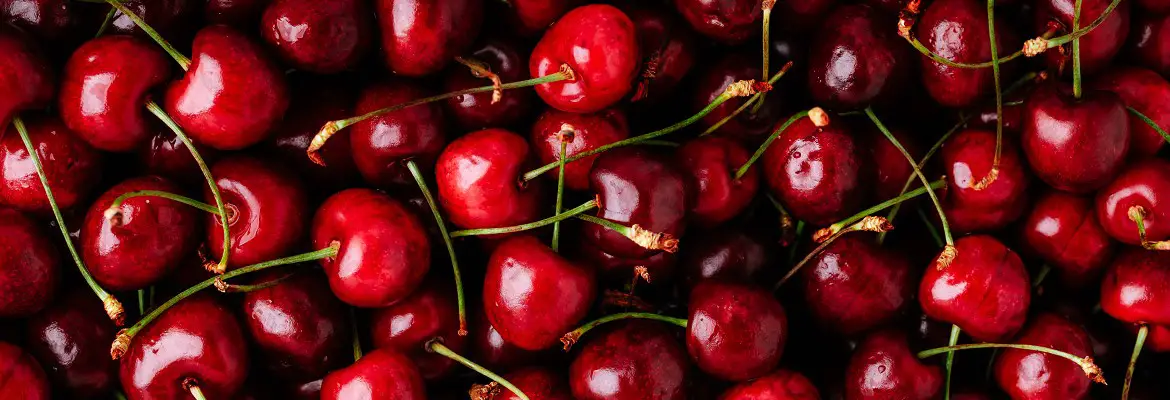Cherry, similar to peach or plum, is a drupe / stone fruit. Cherry has a very recognizable appearance, which is round to oval red/dark red/ crimson red fruit attached to a long and slender stem .
Cherry has a thin, glossy, taut and delicate skin. Cherry has got a very tender pulpy flesh and depending on the variety of the cherry, the flesh can be of various levels of sweetness mixed with a hint of tangy acidic flavor.
The size of cherries vary from variety to variety. For example Lapins Cherries can have a diameter ranging from 2-4 cm (0.8 – 1.5 inches) and Schattenmorelle Cherries can have a diameter ranging from 1-2 cm (0.4-0.8 inches).

Scientific name of Cherries
Prunus Avium
Other names of Cherries
- Sweet Cherry
- Mazzard
- Gean
- Cereza
- Ciliegia
- Cerise
Calories by source in Cherries
- Calories by carbohydrate in Cherries = 91%
- Calories by fat in Cherries = 3%
- Calories by protein in Cherries = 7%
Fats and Fatty Acid profile of Cherries
- Polyunsaturated fat (PUFA) in Cherries = 38%
- Saturated fat (SFA) in Cherries = 28%
- Monounsaturated fat (MUFA) in Cherries = 34%
Nutrition facts of Cherries
*Serving size = 100 grams = 3.55 Ounces = 1/2 cup
*DV= % Daily Value (%DV indicates how much nutrients contribute to a person’s daily diet from a serving of a food. DV assists you in determining whether or not a serving of food is high or low in a particular nutrient.)
| Nutrient | Amount | Unit | DV |
|---|---|---|---|
| Calories | 63 | KCAL | |
| Fat | 0.2 | GRAM | 0% |
| Protein | 1.06 | GRAM | 2% |
| Carbohydrate | 16.01 | GRAM | 6% |
Detailed vitamin profile of Cherries, vitamin A, vitamin B12, vitamin B6, vitamin C, vitamin D, Folate, Niacin, Thiamin, and Riboflavin is shown in the chart.
Detailed mineral profile of Cherries, Sodium(Na), Calcium(Ca), Copper(Cu), Iron(Fe), Magnesium(Mg), Selenium(Se), Phosphorus(P), Potassium(K) and Zinc(Zn) is shown the chart.
Check freshness in Cherries
- Select cherries with green and fresh stem
- Avoid cherries with brittle and brown stem
- Fresh ripe cherries have bright dark red color with a glossy skin texture
- Avoid cherries with bruises, patches and pits
- Old cherries will be mushy and sticky to the touch
- Bad cherries will have white mold starting to develop near the stem
- Select bigger cherries as they are more juicer
Availability of Cherries
- The Seasons of cherries depend on the geographical location where it is being cultivated
- France – Cherry season ranges from May – July
- China – Cherry season ranges from May – July
- Chile – Cherry season ranges from October – January
- Japan – Cherry season ranges from June – July
- Canada – Cherry season ranges from June – August
How to store Cherries
- Storing cherries at room temperature is not recommended
- Avoid direct heat and sunlight while storing cherries
- Cherries can be stored in refrigerator for 1 – 2 weeks
- Washing and storing wet cherries in refrigerator is not recommended
- Cherries can be stored in freezer for almost an year
- Flash freeze the cherries on a tray. After freezing, transfer the cherries in a freeze bag or container and store it in the freezer
Complete nutrition facts of Cherries
Click on the link HERE to download high quality, high resolution and print ready PDF version of the Cherries nutrition chart/infographic.


